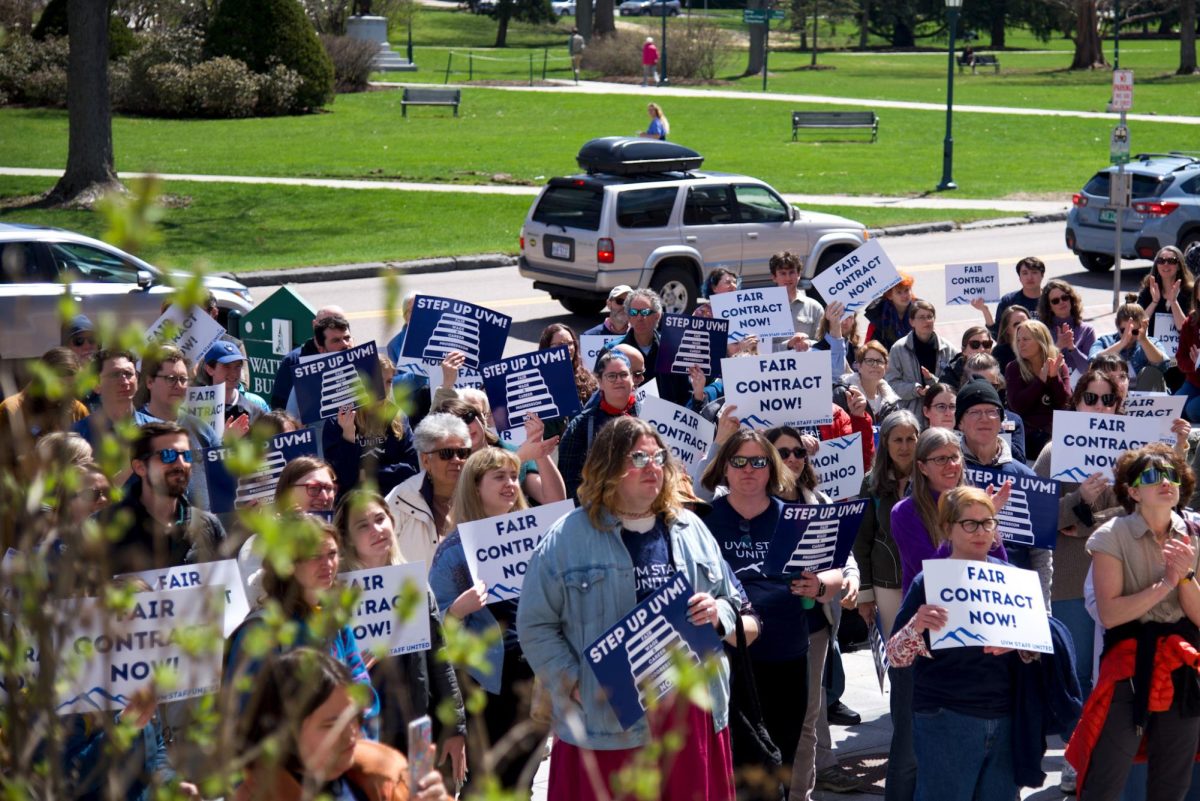We all do it. We complain as we watch the last inch of space on the shuttle bus fill up, turning towards the cold chill of a Vermont winter for the treacherous fifteen minute walk to class.We curse under our visible breath trekking uptown for the 30 minute jaunt home after an off-campus party, grumbling through the snow for the few minutes from our room to the Marche, Simpson or Delahanty. But as we complain about the cold in those few minutes, it is easy to forget the reality for a growing population of the Burlington community.Homelessness is an obvious problem to anyone who has walked downtown. Those with nowhere else to go huddle in doorways or on benches at night, but there are other possibilities.One is the small, unmarked brick building on Church Street, where men and women sit outside, smoking cigarettes. Another is an ordinary Victorian house on Main Street, where the backyard is lined with baby strollers and walls are filled with crayon colors waiting for the next man or woman who brings their families in out of the cold. Both buildings are refuges for those without permanent places to sleep. Run by the Committee on Temporary Shelter (C.O.T.S.) – Burlington’s largest organization for the homeless – these houses provide free, temporary shelter as a haven for those who choose to rely on it.In a report released on Jan. 1, the National Alliance to End Homelessness (N.A.E.H.) announced that an estimated 927 people were considered homeless in the state of Vermont in 2005.While only two states have fewer homeless than Vermont, this number represents .15 percent of the Vermont population.Relating to a state with a much greater figure, nonetheless, the degree of Vermont’s homelessness is magnified.Connecticut, for example, has an estimated 5,357 homeless. This number is proportionally the same percentage as Vermont.This same study estimated 166 homeless in the Burlington / Chittenden County area. Of these, 33 were unsheltered, 114 were individuals and 52 were in families with children.Still, it is difficult to pinpoint exactly how many people in the Burlington area are currently homeless.C.O.T.S. reported that 433 people stayed in their facilities – including 96 families and 129 children – last year. These numbers are not decreasing. In fact, more and more individuals and families with children are coming to C.O.T.S in search of shelter each year. The C.O.T.S. Waystation, an emergency shelter on Church Street, houses individual men and women for the night.Gary (who wished to keep his last name anonymous) has been staying at the facility for over a week, and explained his plight.After selling his trailer in New Hampshire six months ago, he has traveled around Burlington and surrounding towns looking for permanent shelter and work.”I’ve never been homeless before, I always had a place … but I know what I have to do and I’ve been doing it the best I can,” Gary said.At C.O.T.S, Gary finds not only a place to stay for the night, but also during the day in their Daystation, where he can learn about resources available to the homeless, receive supplies and participate in recreational activities.”At the day shelter they’ve given me some clothes, a pair of gloves and my jacket. I don’t ask for much. I just ask for what I need,” Gary said. Families and individuals find themselves in need of C.O.T.S.’s services because of a destructive equation of wages and housing prices, Sally Ballin of C.O.T.S. said.”Wages are static and housing costs have boomed and skyrocketed,” Ballin said. “There is a serious lack of low cost housing in the area.”In Burlington, the fair market rent (a term used in real estate indicating the estimated selling price of a property) for a two-bedroom apartment is $983, a price that has increased steadily over the last several years. Gary said he hopes to be able to afford the $450 rent of an apartment in the C.O.T.S’ owned Wilson Hotel on Church Street.According to the National Low Income Housing Coalition, a person has to make $39,320 annually to afford a $983 monthly rent. The method used to determine “affordability” allows for 30 per cent of a person’s income to go towards rent.This annual income translates into $18.90 an hour, far more than the $10.60 an hour livable wage given by the University of Vermont, and more than twice as much as the Vermont minimum wage of $7.25.In order for a worker at the University of Vermont – making $10.60 an hour – to afford an apartment at this rent, he or she would have to work 71 hours a week, 52 weeks of the year.For a person making minimum wage in Burlington, he or she would have to work 102 hours a week 52 weeks of the year.Nonetheless, in many cases the families in shelters have two parents, both employed at full-time jobs, Ballin stated.In order for a family to afford an apartment on a minimum wage, they would need 2.6 people working 40 hours a week.Burlington’s government has attempted to solve the lack of affordable housing in the area.The Community & Economic Development Office of the City of Burlington stated, “The City recognizes that the free market for housing is often not a fair market for low and moderate income residents.” Last year, the City Council “identified affordable housing as one of its top three priorities for the year and has begun looking at local initiatives to address the housing crisis.”Yet the market rates of rent are still rising, while organizations like C.O.T.S. attempt to make up for those left behind. Individuals and families are not the only parties at risk of homelessness and difficulty finding affordable housing. There is a significant number of young men and women living without homes in the Burlington area.While C.O.T.S.’s facilities allow families to stay the night, individuals must be 18 years of age or older.Many young men and women – some as young as 14 – find themselves searching for shelter alone. Spectrum Youth and Family Services works within the Burlington community, assisting homeless youth between the ages of 14 and 21.Last year, Spectrum housed 122 youths in their emergency shelter, but Spectrum is dedicated to carrying their work further than at night. According to their annual report, “When a young person comes to the shelter they are assigned a professional team that works like a family and a community to support them.”The organization is not concerned with just giving kids a bed for the night, Joan White, a Spectrum representative, stated.”We provide youths with shelter and also programs to help them get their lives back on track,” White said. While Spectrum may only have 13 beds in its Emergency Shelter, the organization has a multitude of programs that help young people to finish their education, develop life skills, find jobs and permanent housing and receive counseling and medical care.In addition, a large portion of Spectrum’s work is done on the street. Last year, the organization’s Street Outreach program appealed to 525 homeless and at-risk youths, encouraging them to seek out Spectrum’s other services and providing them with counseling, basic first aid and supplies. Many kids end up in need of Spectrum’s services due to unsafe family situations, substance abuse or gaps in the foster system.For many, these hard times are not going away.A study by Kids Count, a national organization to track the wellbeing of children in the U.S., found that in 2005 26 percent of 18 to 24 year-olds living in Vermont were living in poverty – up five percent since 2004. 14 percent of this age group do not work, attend school nor have received a degree past a high school diploma or GED, compared to 10 percent the year before.The numbers provided by C.O.T.S and Spectrum add up to more than the National Alliance to End Homelessness’ statistic.These organizations are only a glimpse at the facilities available to the homeless of Burlington. C.O.T.S. alone has six housing programs besides the Waystation. Spectrum has three additional residency programs. The Burlington Emergency Shelter also provides the homeless of Burlington with shelter and services.Whatever the causes are of a person’s homelessness – whether it’s housing costs or disproportionately low paychecks, the unhoused in Burlington are a significant problem that can easily slide under the radar of other residents.The true depth of the problem cannot be seen simply by walking down Church Street, but in the lives of those in need; their issues and, most strikingly, their optimism.Wayne Dow, a 53 year-old homeless man, has continued to live life to the absolute fullest; on Feb. 14, he married his fianc??e, Theresa Ladue, who is also homeless.”This is the best there is,” Dow told the Burlington Free Press. “Nothing can beat this.”Gary also refuses to lose hope and is ready to move on from this stage in his life.”It’s been a long road, a long winding road. Up and down like a rollercoaster,” Gary said. “I’m sick of this kind of life. I just want some peace of mind, some rest and a place of my own.”












